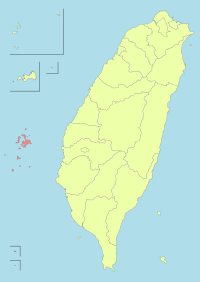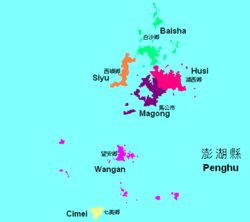- Penghu
-
Penghu County
澎湖縣
Abbreviation(s): Penghu (澎湖)
County seat Magong City Region Taiwan Strait County Magistrate Chien-fa Wang (王乾發) Cities 1 Townships 5 Area - Total 141.052 km²
(22 of 25)- % water 0 % Population - Total 93,446 (January 2009)
(23 of 25)- Density 662.49/km² Symbols - County flower Firewheel (Gaillardia pulchella) - County tree Chinese Banyan (Ficus microcarpa) - County bird Small Skylark (Alauda gulgula) Official websites www.penghu.gov.tw Penghu Traditional Chinese 澎湖群島 Simplified Chinese 澎湖群岛 Transcriptions Mandarin - Hanyu Pinyin Pénghú Qúndăo - Tongyong Pinyin Pénghú Cyúndăo - Wade–Giles P'eng-Hu Ch'ün-Tao - Yale Romanization Pénghú Chyúndău Min - Hokkien POJ Phêⁿ-ô·-kûn-tó Literal meaning fishermen The Penghu Islands, also known as Pescadores (from Portuguese: "fishermen") are an archipelago off the western coast of Taiwan in the Taiwan Strait consisting of 90 small islands and islets covering an area of 141 square kilometers.
The whole archipelago forms Penghu County, Taiwan Province of Republic of China ("Taiwan"), the archipelago along with the island of Taiwan, composed the former Japanese territory of Formosa.
Contents
History
'Peng-hu' was first recorded in unofficial historical records and regional logs in 1171 during the Southern Song Dynasty.[1] From the middle of the 17th century to 1895, Taiwan and the archipelago were ruled by pirates, the colonial Dutch Empire (attempts at conquest from 1622 onward), the Koxinga kingdom, and the Qing Dynasty, successively.
Sino-French War
The Penghu archipelago was captured by the French in March 1885, in the closing weeks of the Sino-French War, and evacuated four months later. The Pescadores Campaign was the last campaign of Admiral Amédée Courbet, whose naval victories during the war had made him a national hero in France. Courbet was among several French soldiers and sailors who succumbed to cholera during the French occupation of Penghu. He died aboard his flagship Bayard in Makung harbour on 11 June 1885.[2]
First Sino-Japanese War
Defeated in northern China by the Japanese in the First Sino-Japanese War, the Qing government ceded the islands to Japan along with Taiwan in the Sino-Japanese Treaty of Shimonoseki of April 1895. The Japanese suspected that they might meet resistance when they attempted to occupy Taiwan, and their invasion of Taiwan, hastily launched in late May 1895 in response to the proclamation of the Republic of Formosa, was preceded by an attack on Qing forces on Penghu in March 1895, in which the Japanese defeated the Chinese garrison of the islands and occupied Makung. The Japanese occupation of Penghu prevented more Chinese troops from being sent to Taiwan, persuaded the Chinese negotiators at Shimonoseki that Japan was determined to annex Taiwan, and helped to ensure the success of the subsequent Japanese invasion of Taiwan.[3]
Second Sino-Japanese War
In the Second Sino-Japanese War, Mako (Makung) was a major base for the Imperial Japanese Navy and embarkation point for the invasion of the Philippines.
Cairo Declaration
In the Cairo Declaration of 1943, the United States, United Kingdom, and China stated it to be their purpose that "all the territories that Japan has stolen from the Chinese, such as Formosa and The Pescadores, shall be restored to the Republic of China."
On 26 July 1945, the three governments issued the Potsdam Declaration, declaring that "the terms of the Cairo Declaration shall be carried out." In the Treaty of San Francisco, Japan renounced sovereignty over Taiwan and Penghu but left their final disposition unsettled. The archipelago has been administered by the Republic of China.
In the early 1990s the Penghu National Scenic Area that comprises most but not all of the islands and islets of the archipelago was created. Tourism has since become one of the main sources of income of the county.
China Airlines Disaster
On 25 May 2002, China Airlines Flight 611, a Boeing 747-200 aircraft flying from Taipei, Taiwan to Hong Kong disintegrated and exploded over the Islands. The wreckage slammed into the Taiwan Strait a couple of miles off the coast. All 225 passengers and crew on board were killed.[4]
Relationship to Taiwan
Despite the controversy over the political status of Taiwan, both the Republic of China and the People's Republic of China agree that Penghu is a county in (their own respective) "Taiwan Province" (Taiwan Province, Republic of China and Taiwan Province, People's Republic of China). However, geographically, the island of Taiwan does not include Penghu, although it is closer to Taiwan than the mainland. Thus Penghu is listed separately from "Taiwan" in some contexts, e.g. the Separate Customs Territory of Taiwan, Penghu, Kinmen, and Matsu (the official WTO name for the Republic of China); in the Treaty of Shimonoseki, the Cairo Declaration, and the Treaty of San Francisco (see above); and in the introduction to the Republic of China article.
Sub-county divisions
Name (Hanyu Pinyin) Hanzi Wade-Giles Tongyong Pinyin Hanyu Pinyin Taiwanese (POJ) Hakka Pha̍k-fa-sṳ Literal meaning City Magong City 馬公市 Ma-kung Magong Mǎgōng Má-keng Mâ-kûng originally Matsu Palace Rural township Huxi Township 湖西鄉 Hu-hsi Husi Húxī Ô͘-sai Fù-sî Lake West / West of Penghu Baisha Township 白沙鄉 Pai-sha Baisha Báishā Pe̍h-soa Pha̍k-sâ White Sand Xiyu Township 西嶼鄉 Hsi-yü Siyu Xīyǔ Sai-sū Sî-yí Western Isle Qimei Township 七美鄉 Ch'i-mei Cimei Qīmei Chhit-bí Tshit-mî Seven Beauties Wang'an Township 望安鄉 Wang-an Wang-an Wàng'ān Bāng-oaⁿ Mong-ôn Hope Safe Altogether, there are 97 villages.
The main islands of Magong City/Husi Township, Baisha Township, and Siyu Township are the three most populous islands and are connected via bridges. Two shorter bridges connect Husi and Baisha. The bridge connecting Baisha and Siyu is the longest bridge in the Republic of China and is called the Penghu Trans-Oceanic Bridge (澎湖跨海大橋 Peng Hu Kua Hai Da Qiao).
See also
- Administrative divisions of the Republic of China
- Republic of China
- China Airlines Flight 611
- List of cities in the Republic of China (Taiwan)
- Penghu National Scenic Area
- Township (Republic of China)
Notes
- ^ "THE FOOTPRINTS OF THE ANCIENT PEOPLE". Penghu Reclamation Hall. http://phkt.phhcc.gov.tw/english/content/index_2.asp?m=&m1=11&m2=140&gp=&sid=&keyword=&id=143. Retrieved 25 October 2010.
- ^ Loir, 291–317
- ^ Takekoshi, 80–2
- ^ Barron, Lisa (28 May 2002). "China Airlines safety record in the spotlight". Cable News Network LP, LLLP. Archived from the original on 25 October 2010. http://www.webcitation.org/5tkHP2Zpr. Retrieved 25 October 2010.
References
- Loir, M., L'escadre de l'amiral Courbet (Paris, 1886)
- Yosaburo Takekoshi, Japanese Rule in Formosa (London, 1907)
External links
- Penghu travel guide from Wikitravel
- Penghu County Government Official Website
- Penghu Tour Official Website
- 澎湖研究學術研討會 第1-8屆論文輯全球資訊網-歷屆論文 (Traditional Chinese)
 Administrative divisions of the Republic of China(Otherwise known as Taiwan).
Administrative divisions of the Republic of China(Otherwise known as Taiwan).Special municipalities 
Taiwan Province CitiesFujian Province See also: Free Area of the Republic of China.Cities and townships in the Taiwan strait islands of the Republic of China County seats are in BoldTaiwan - Baisha
- Huxi
- Qimei
- Xiyu
- Wang'an
Fukien - Jincheng
- Jinsha
- Jinhu
- Jinning
- Lieyu
- Wuqiu
Language Chinese-speaking nations and regions Categories:- Islands of Taiwan
- Penghu County
- Counties of Taiwan
Wikimedia Foundation. 2010.


